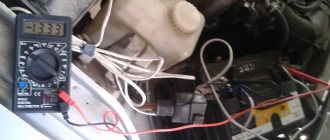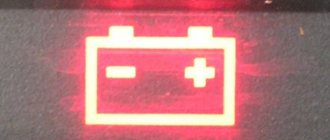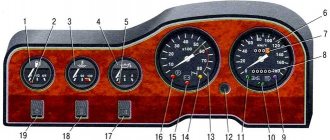The battery indicator on the dashboard is designed to monitor the correct operation of the battery-alternator circuit and the condition of the on-board power supply elements. When the ignition is turned on, the battery charging lamp should light up - the absence of an indication warns the driver of a malfunction of any component or mechanism. To properly diagnose a malfunction, it is necessary to understand the structure and functions of all components in the system.
- Battery
- Diode to minus.
- Control diode.
- Generator.
- Diode to "plus".
- Stator.
- Relay-voltage regulator.
- Rotor.
- Capacitor jumper.
- Fuse box.
- Charge indicator with light bulb.
- Voltmeter.
- Ignition coil distributor relay.
- Ignition coil with lock.
While the generator is operating, the battery is charged through a diode bridge and relays, which provide a constant voltage of 13.2 - 14.6 Volts. When you turn on the ignition - turn the key in the lock, the excitation circuit in the on-board network components is activated, equalizing the voltage values at the terminals of the generator and battery. After the phase voltage has equalized, the control light goes out and the system operates in normal mode.
Attention! The battery must be in a charged state during its entire service life - if left for a long time with a low charge level, rapid sulfation of the plates and loss of capacity occurs.
In modern cars, there is no provision for a voltmeter on the instrument panel - the state of the circuit is controlled by an electronic control system: sensors take readings and send data to the unit controller. The ECM analyzes failures, recording them as error codes in the memory log. Typical breakdowns can be identified independently by checking each element sequentially in a certain area.
Main reasons
- The battery is dead - the most common reason. When the on-board power supply is turned on and the key is turned in the ignition switch before the engine starts, the voltage drops to a critical level, the control light does not light up, the rest of the indications on the instrument panel are dim, and starting the power unit is impossible.
- Blown fuse – a failed fuse in the mounting block cuts off the power to the battery light. As a rule, in the general circuit it is responsible for the entire backlight of the instrument panel with a rating of 10 Amps.
- A malfunction of the electrical circuit - oxidation of the contacts on the connectors, or poorly secured terminals, a fuse in the socket or a break in the wiring section leads to failure of the battery indicator. The problem can also be caused by broken insulation - short circuits.
- The indicator has burned out - the LED (light bulb) has failed.
- The fuse relay is faulty - in domestic car models (VAZ classics), the fuse mounting block is equipped with a relay for each circuit separately. Failure of the relay in the area to the indicator turns off the power.
- Other reasons are a breakdown of the generator unit. The diode bridge or voltage relay does not work properly, voltage surges occur in the network as the engine speed increases, the battery does not charge (in such cases, the light may be on constantly, or flicker and then turn off).
The battery light comes on dimly when the ignition is turned on.
The indicator in question is designed to let the driver know whether the battery is charging or whether the entire electrical network is powered directly from the battery while driving.
When the ignition is turned on, all warning lamps light up; when the engine starts, all indicators should go out. In this case, the battery charging system is working properly and there is nothing to worry about.
There can be only one reason why the battery warning light comes on while the engine is running - there is no voltage supply from the generator or its value is insufficient.
The main malfunctions that lead to this:
- Lack of quality contact at the battery terminals.
- Damage to the alternator belt or loose tension.
- There is no negative contact with ground.
- An open circuit in the rotor excitation circuit or worn brushes in the generator.
- Failures of the diode bridge are usually accompanied by a dim lighting of the battery light on the dashboard.
- Fuse failure.
- Malfunction of the relay regulator.
Before you start troubleshooting, pay attention to why the lamp is on. If there is no voltage supplied to the battery at all, then the lamp lights up correctly. In another situation, the operation of the signal indicator while charging is present significantly complicates the problem.
First of all, determine whether there is voltage on the battery. To do this, take a voltmeter (multimeter), start the engine and measure the required characteristic at the battery terminals.
If everything is in good condition, you will see readings in the range from 13.6 to 14.2 V. In this case, the battery is charging properly. If the results obtained differ significantly from normal, then there is some kind of breakdown in the system.
Experts identify several reasons why the battery charging light on the panel does not light up, and a corresponding number of troubleshooting methods.
For self-diagnosis, sometimes it is enough to read the car’s operating manual and become familiar with the basics in the field of vehicle electricals. But with repairs things are more complicated.
The category of dangerous causes includes situations where repairs are urgently needed due to problems in the electrical circuit and broken wiring. Burnt out light bulbs, loss of battery charge, etc. are considered safe.
To prevent a harmless situation from turning into a potentially very dangerous one, if a problem is detected, you need to check and fix the problem.
The experience of auto electricians shows that failure of the battery charging indicator from the generator occurs due to:
- battery;
- the indicator lights on the panel;
- fuse;
- problems in the electrical circuit.
Each of the reasons has its own degree of complexity.
One of the reasons why the battery charging lamp does not light up when you turn on the ignition may be that the battery itself is discharged under the hood of the car.
This indicates that the battery has run out of charge. It needs to be charged.
But don't rush to rejoice. Yes, it really happens that the battery is dead because the driver forgot to turn off the headlights at night or some other consumer. He took all the charge. The charger is connected and the battery is restored. Accordingly, the indication lamp begins to work normally.
But there is also a downside. It cannot be ruled out that the battery itself has failed, can no longer be repaired or restored, and an attempt to charge it will end in failure. If the fault is not in the contacts or wires, then the problem can be solved by installing a new battery.
More serious reasons include a malfunction of the generator itself, which is responsible for restoring the charge in the battery while the car is moving. If the generator fails or has any malfunctions, diagnostics will be required. It will show whether repair is possible or whether a new generator will have to be installed.
When installing the same new powerful acoustics, consider additionally replacing the generator with a more powerful one. Otherwise, the device simply will not cope with such consumers.
The most seemingly harmless situation, due to which the battery charging lamp does not light up immediately when the ignition is turned on.
Don't rush to change the battery or generator. There is a possibility that the warning light on the dashboard has simply burned out.
There may be several reasons:
- natural burnout over a long period of operation;
- initially low quality of the lamp;
- abnormal instrument panel on the car;
- strong vibrations and shaking that caused a breakdown.
Even if the reason lies in a burnt-out light bulb on the dashboard, it is recommended to change it immediately. Without it, you will not be able to control the charge level and respond in a timely manner to changes in the operation of the generator.
This is possible on a car where the generator does not have a built-in resistance. Due to it, the equipment continues to generate energy even in situations where the indicator light has burned out.
Fuse
Next in line is the fuse. Because of it, sometimes the battery light does not light up when the ignition is turned on, which causes confusion and panic in the driver.
Diagnostics
The search for a faulty element begins with checking the battery charge level. To measure the voltage at the terminals, use a multimeter or voltmeter. It is necessary to take readings in two modes:
- without load with the ignition turned off and the minus terminal removed;
- under load: by turning the key in the ignition and turning on any consumer (low beam headlights, air conditioning).
The multimeter probes in voltmeter mode are connected in series: the positive terminal is a red contact, the negative terminal is a black one. The normal value of the battery voltage at rest with a 100% charge is 12.05 - 12.6 Volts.
Important!
The battery voltage directly depends on the state of charge: if the level is reduced to 10%, then the maximum voltage without load at the terminals will be about 11.3 Volts.
The test under load should be carried out carefully, observing safety precautions: when turning on the ignition, do not touch the power terminal and cable with your bare hands. The multimeter readings are taken twice: when the engine starts, and after 20-30 seconds. When starting the engine, the power current can reach a peak of up to 670 Amps, depending on the power of the unit. The battery supplies a significant part of the energy to the starter for the initial crankshaft rotation - at this moment the voltage at the terminals drops. A value of 8-9 V is considered normal; if the drop during startup is critical and reaches 6 V, then the battery is completely faulty.
Accumulator charging
To determine the reasons for the unstable operation of the light bulb, you first need to understand the intricacies of the interaction between the generator and the direct current source. The fact is that when the power unit is operating, the car battery receives a constant voltage of 13.6-14.2 V. At the same time, the generator generates electric current. The voltage value directly depends on the speed of the generating device. Accordingly, the higher the speed, the higher the voltage value will be. Stabilization of the output voltage occurs through a regulator connected to the rotor winding circuit. When the charging current is supplied within the limits acceptable for normal battery operation, the light on the instrument panel will not light up. A constant glow of the light will indicate that there is a malfunction in the generator or supply wires. In most cases, the source of the problem is a torn or weakened drive belt.
Solutions to the problem
| Reason for violation | Remedy |
| Discharged battery | Charge the battery |
| Blown fuse | Replacing an element |
| Oxidation of battery terminals | Cleaning the contacts with fine-grained sandpaper and treating with an anti-corrosion compound |
| Power cable insulation failure | Replacing the wire from the battery to the generator |
| Broken wiring in a section of the circuit | Repair the break, or replace the wire on the segment with a new one |
| Faulty contacts at the ignition coil terminals, fuse mounting in the socket, rotor leads, or indicator light | Secure the terminals, having previously cleaned them of oxides. |
| Worn mounting block relay | Relay replacement |
| Diode bridge failure | Replacing one of the diodes or the entire block |
| Failure of the generator voltage regulator relay | Relay replacement |
| ECU error | Reset the error (reboot the system by turning the ignition on and off for at least 15 seconds) |
Low battery
Another common reason why the battery warning light does not light up when the ignition is turned on in a VAZ 2106 - 2107 is a weak battery.
If, at the same time that the battery light does not light up, the dashboard instruments do not turn on or are dimly lit, then this is a clear sign of a low battery. The problem can be “cured” by simply charging the battery.
Good battery
However, not all so simple. The discharge of a car battery may not occur because the owner did not have time to charge it in time or forgot to turn off the headlights. A problem with a battery becomes dangerous if the cause lies in the generating device. As you know, the battery must be charged while the car is moving, otherwise it will discharge quite quickly. And this function falls on the generator. But if the latter is faulty, then problems arise.
Thus, a seemingly trivial reason may indicate a damaged car generator, which performs many useful functions. Obviously, a thorough diagnosis should be carried out, the cause should be found and eliminated.
Confronting attackers
Due to the fact that the battery is not cheap, the issue of protecting the VAZ 2107 battery from theft is quite acute. It’s not difficult to open the hood of a “classic,” which is why thieves are keeping a close eye on the “Sevens.”
Experts offer several options for preventing theft.
- Secure parking or secure garage.
- Alarm installation.
- Installation of the hood lock. Let’s be clear right away: few people take this step. Welding work is required, the appearance deteriorates, and it is quite easy for a professional to pick the lock.
- Take the battery with you. Labor-intensive, inconvenient, but effective. On the other hand, if the car is left for a short time, it is defenseless: they can even remove the battery in a supermarket parking lot.
- Reliable battery fixation. Almost the most popular method. The fasteners are secured with a secret that prevents dismantling and makes theft difficult. In combination with an alarm it is a very effective technique.
But all experts agree that the most reliable protection for the VAZ 2107 battery against theft is comprehensive. A combination of multidirectional measures will give the best results!
Indicator modes
The following combination is very common: green, white, black. However, some manufacturers use the following combination: green, white, red. But essentially it's the same thing. Let's go through these readings.
Green mode – fully charged battery, can be used in normal normal mode. That is, charging is not needed.
White indicator - it tells us that the electrolyte level is low. This also happens in unattended ones; most likely, the battery was often recharged, and gaseous electrolyte was released through a special valve. You need to disassemble and add distilled water.
A black or red indicator - this tells us that our battery is low, and the indicator is critical and requires mandatory recharging! It is important! If the battery is left uncharged for a long time, it may fail.
As you can see, these colors give certain signals to the owner, look occasionally and then your battery will last a long time. I also want to note that this indicator does not have any light bulbs in its structure, the next point will change your understanding...
A little theory
On our website we have already described in detail the structure of a car generator. Let's just say that electricity is generated in it by the rotation of the crankshaft.
As the speed increases, the voltage also increases, but it must be within the limits indicated above, otherwise the battery will be overcharged, which threatens the electrolyte boiling and sulfation of the plates.
To prevent this from happening, a relay regulator is installed in the rotor excitation circuit, thanks to which a stable voltage is supplied to the battery.
The signal from the generator to the warning lamp is transmitted through a fuse, which is also located in the generator itself. Accordingly, the light stays on until the generator starts working and transmits voltage to the battery.
The charge from the generator passes through:
- Diode;
- Regulator;
- Generator brush;
- Slip rings;
- Winding and wiring.
Thus, if at least one of these elements does not work correctly or fails, the readings of the light bulb cannot be trusted, although charging may be supplied to the battery.
What else to check
- Voltage regulator;
- Generator rectifier unit;
- Diodes;
- Generator for broken windings;
- Generator brush assembly;
- Contacts on the terminals of the generator, mounting block.
Let's continue... Diodes are checked with a test light or multimeter. If one of them is broken, the entire rectifier will have to be replaced.
To check the stator winding you need the same device. The resistance between the fasteners of the rectifier unit is measured. If there are no contacts between them, you need to replace either the winding or the entire generator.
The generator itself often fails due to wear on the brushes. To check them, you need to remove the brush assembly and measure the length of the elements. If it is 5 mm or less, the brushes must be replaced.
Almost all of the above system components are replaced when they fail, since they cannot be repaired. Only some of the generator problems can be repaired, but this can only be done by a qualified auto electrician.
The worst thing is if problems with recharging occur while on the road. Without recharging the battery, it will eventually run out completely. And even if you manage to find the cause of the breakdown and eliminate it, you will no longer be able to start the engine with the starter. It will be possible to start a VAZ-2017 with a dead battery only from a tug or pusher.
Checking fuses of VAZ 2106 - 2107 with a multimeter
You also need to know how to check a fuse in a car with a multimeter because in some cases replacing it does not eliminate the malfunction; the circuit needs a more thorough check. Usually its failure is visible to the naked eye, but in some cases the break can be detected only after an instrumental check. To do this, use a car tester or even a simple voltmeter to measure direct current.
- We attach the probes to the fuse.
- Next, using simple manipulations, we melt the wiring inside the fuse. Therefore, we made a non-working fuse out of a working fuse. What won’t you do for a good article!? :-). Again we apply the probes to the fuse and look at the behavior of the multimeter.
- The resistance is infinitely large, we do not hear any sound signal like “peep”. The fuse is broken. It can be thrown into the trash bin.
A light bulb may burn out due to a faulty electrical circuit.
A problem with the circuit that powers the battery light can be caused by several things. Let's consider everything.
So, problems with contacts are becoming quite common. Usually this situation occurs in the spring, after cold weather. During the winter months, moisture accumulates on the connectors, causing the formation of oxides. This makes the contact much worse, as a result of which the indicator stops turning on.
Electrical circuit diagram of VAZ 2107
As a rule, this problem does not appear immediately and is not stable. In other words, the light bulb may light up one time and not another time. The solution to this problem is to clean all connectors. They should be treated with a grease specifically designed for this purpose.
The light bulb may burn out due to an open circuit. To make sure of this, you should arm yourself with a multimeter. The device checks the circuit to determine the faulty section.
Why does the indicator on the battery not light up after charging?
In addition to its design simplicity, the device is not particularly reliable. The hydrometer balls may not float to the surface for various reasons or may interfere with one another.
But it is quite possible that the indicator really indicates the need for battery service. The charge went well, the electrolyte gained a high density, but it was not enough to trigger the indicator. This position corresponds to black or white color in the eye.
But something else happens - all the battery banks have received a charge, except the one where the indicator is installed. Such a run-up of elements when connected in series occurs in long-serving batteries that have not been subjected to equalization of the elements.
A specialist should deal with such a battery; perhaps it can still be saved if it is economically justified. The work of a specialist is quite expensive compared to the prices of budget batteries.
A light bulb may burn out due to a faulty electrical circuit.
A problem with the circuit that powers the battery light can be caused by several things. Let's consider everything.
So, problems with contacts are becoming quite common. Usually this situation occurs in the spring, after cold weather. During the winter months, moisture accumulates on the connectors, causing the formation of oxides. This makes the contact much worse, as a result of which the indicator stops turning on.
Electrical circuit diagram of VAZ 2107
As a rule, this problem does not appear immediately and is not stable. In other words, the light bulb may light up one time and not another time. The solution to this problem is to clean all connectors. They should be treated with a grease specifically designed for this purpose.
The light bulb may burn out due to an open circuit. To make sure of this, you should arm yourself with a multimeter. The device checks the circuit to determine the faulty section.











